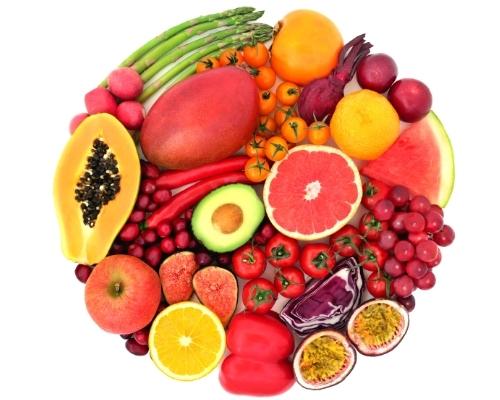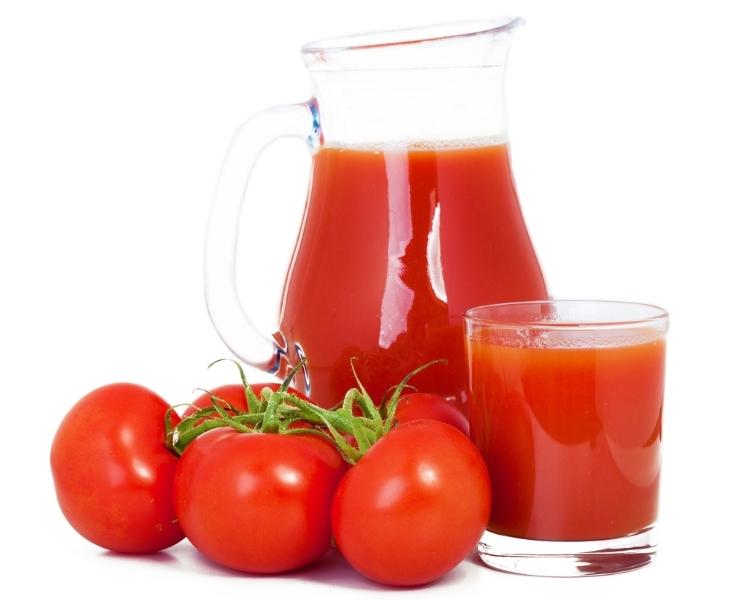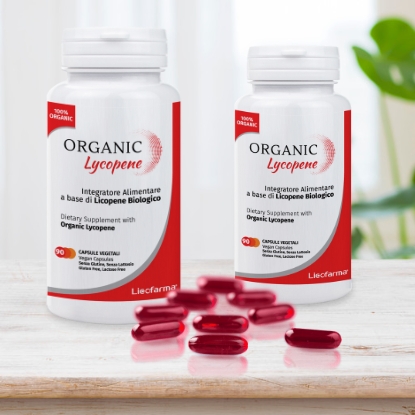Lycopene: Properties and Benefits
Lycopene What It's for and What It Is
Lycopene is a natural antioxidant, a bioactive substance of plant origin found in certain species of fruits and vegetables to which it gives the typical red, orange or yellow color, depending on the concentration of pigment present in the vegetable itself. It belongs to the Carotenoid family and owes its name to the scientific name of the tomato, Solanum Lycopersicum, the fruit that contains most of it.
Specifically, Lycopene is the carotenoid most commonly found in human blood and tissues, followed in order by the other carotenoids Beta-carotene, Lutein, and Zeaxanthin.
Lycopene: Structure Formula
From the perspective of chemical characteristics, Lycopene is an acyclic isomer of beta-carotene, that is, they have the same molecular formula but with the atoms positioned differently. Specifically, the Lycopene molecule is characterized by a long chain of 40 carbon atoms (C40H56) with 11 conjugated and 2 unconjugated double bonds.
Because of their structure, Lycopene molecules upon exposure to light, thermal energy or chemical reactions undergo the process of trans-cis isomerization. In nature it is found 90% in trans form, the thermodynamically most stable form, while in the human body it is mainly present in cis form, the most bioavailable form.
Lycopene: Properties and Benefits
Lycopene is the carotenoid with the greatest antioxidant action, i.e., it helps our body fight oxidative stress, a pathological condition caused by an excess of free radicals that the body cannot dispose of naturally. The main effect of this condition is an acceleration of cellular aging processes and the activation of a series of inflammatory and degenerative reactions that can contribute to an increased incidence of numerous diseases. In particular, some heart diseases (hypertension and atherosclerosis), diabetes, obesity, neurodegenerative diseases, and even some forms of cancer such as prostate cancer.
So what is Lycopene used for? Its main function is to capture and neutralize excess free radicals (it basically oxidizes instead of cellular structures). In this way it helps the body restore the physiological balance between free radical production and elimination, helping to limit the risk of the onset of certain diseases, particularly those in which oxidative stress plays a key role.
Dwelling on Lycopene and its benefits, numerous studies would seem to confirm that Lycopene's antioxidant action could make it useful for:
- treat and reduce the risk of prostate disease, particularly benign prostatic hypertrophy and inflammation (prostatitis);
- reduce the risk of developing cardiovascular disease (hypertension, heart attack, atherosclerosis) due to its ability to reduce LDL cholesterol oxidation levels;
- protect the skin from aging and damage caused by solar radiation (photoprotection);
- protect eye health, particularly the retina, by helping to reduce the risk of diseases such as age-related macular degeneration;
- enhance physical activity by helping to counteract the harmful effects of free radicals produced during strenuous exercise.
Finally, it may also be useful in treating osteoporosis and menopausal symptoms and in improving the body's immune response.
Where Lycopene is Found in the Human Body
Lycopene is the carotenoid most commonly found in the human body. In addition to blood, it is found in abundance in adipose tissue, testes, adrenal glands, liver, prostate, and breast. Being a lipophilic substance (it needs fats to be carried), in fact, its distribution in body tissues depends on the greater or lesser presence of lipids.
Foods Containing Lycopene
Although Lycopene is the carotenoid most commonly found in the human body, the human body is unable to synthesize it and, therefore, it can only be assimilated through the diet. Considering the beneficial properties of this antioxidant, it is imperative to know where Lycopene is found in foods so as to ensure proper dietary intake.
The foods richest in Lycopene include, in first place, ripe tomatoes and their derivatives (sauces, sauces, juices), which are the main source of Lycopene, followed by other vegetables that contain less, such as watermelon, blood oranges, melon, guava, pink and red grapefruit, apricots, papaya, and red cabbage.
Lycopene and Tomato
In Western countries, particularly those in the Mediterranean area, more than 80 percent of dietary Lycopene intake comes from the consumption of tomatoes and their derivatives. Not all tomatoes contain the same amount of Lycopene as its concentration depends on variety and degree of ripeness. The richest are ripe, deep red tomatoes, which can contain as much as 3 to 10 mg per 100 g of fresh fruit, concentrated mainly in the skin.
Compared to fresh tomatoes, their derivatives i.e., juices, concentrates, purees, and sauces have a significantly higher Lycopene content. That is why to assimilate more Lycopene it is recommended to consume cooked tomatoes, since due to its physical-chemical characteristics heat makes it much more bioavailable.
| Food Source | Lycopene Content (mg per 100g of product) |
| Tomato Powder | 46,3 |
| Dry Tomatoes | 45,9 |
| Tomato Concentrate | 42,2 |
| Canned Tomato | 28,8 |
| Tomato Puree | 21,8 |
| Tomato Sauce | 17,2 |
| Ketchup | 15,9 |
| Cooked Tomato Sauce | 14,1 |
| Tomato Preserve | 10,9 |
| Tomato Juice | 9,5 |
| Fresh Tomato | 3,0 |
| Peeled Tomato in Can | 2,8 |
The concentration of Lycopene in fresh fruit also depends on environmental factors and the growing process. For example, organic tomatoes have been shown to have a higher concentration of lycopene and other nutrients than the fruit of conventionally grown plants.
Bioavailability of Lycopene
Bioavailability of a substance refers to its ability to be assimilated by the body and utilized for the various physiological functions for which it is intended. The bioavailability of Lycopene is controlled by several factors related to the specific characteristics of the food, the mode of intake, and the state of the body. Particularly in fresh tomatoes, Lycopene is enclosed within a matrix, which hinders its release making it poorly bioavailable.
To make it assimilable by the body this matrix must be "broken down," and this is done by subjecting it to heat or other processes such as chopping. This explains why tomato paste or puree or tomato powder is much more bioavailable than fresh tomato. In addition, the bioavailability of Lycopene increases when taken in combination with oils or other fats, such as olive oil. In the case of the active ingredient extracted to be used as a raw material for formulating dietary supplements, bioavailability also depends on the extraction process used.
Learn about our high bioavailability Organic Lycopene.
Recommended Daily Dose of Lycopene
Currently, the recommended dose of Lycopene is between 10 and 15 mg per day, with the possibility of increasing the amount to about 50 mg per day as reported in a recent communication from EFSA, the European Food Safety Authority. In general, already adopting the typical indications of the Mediterranean diet, for example, a plate of pasta dressed with about 50 g of tomato sauce and olive oil covers the proper daily requirement of Lycopene.
Lycopene: Side Effects and Contraindications
Regarding Lycopene intake and contraindications, as also confirmed by EFSA, this molecule is considered safe whether taken through food, dietary supplementation or as a food colorant. Of course, as with all nutrients, its supplementation is necessary only when a certain deficiency is established. Moreover, in cases of pregnancy and lactation it should be taken only through the diet and not in supplement form. In any case, it is always a good idea to seek advice from your medical professional.
Bibliographical References
- Nguyen ML, Schwartz SJ. Lycopene: chemical and biological properties. Food Technol. 1999; 53:38-45.
- Canene-Adams K, Campbell JK, Zaripheh S, et al. The tomato as a functional food. J Nutr. 2005; 135:1226-30.
- Rescio L, Di Maio A, Cazzola P. Lycopene, photoprotection and skincare: the benefits of organic quality. J Plastic Dermatol. 2010; 6:37-47.
- Gartner C, Stahl W & Sies H. Lycopene is more bioavailable from tomato paste than from fresh tomatoes. Am J Clin Nutr. 1997; 6:116-122.
- Porrini M, Riso P, Testolin G. Absorption of lycopene from single or daily portions of raw and processed tomato. Br J Nutr. 1998; 80:353-361.
- Palozza P, Catalano A, Simone R, Cittadini A. Lycopene as a guardian of redox signalling. Acta Biochim Pol. 2012; 59:21-5.
- Rao AV. Processed tomato products as a source of dietary lycopene: bioavailability and antioxidant properties. Can J Diet Pract Res 2004; 65:161-165.
- U.S. Department of Agriculture, Agricultural Research Service, 2011.





